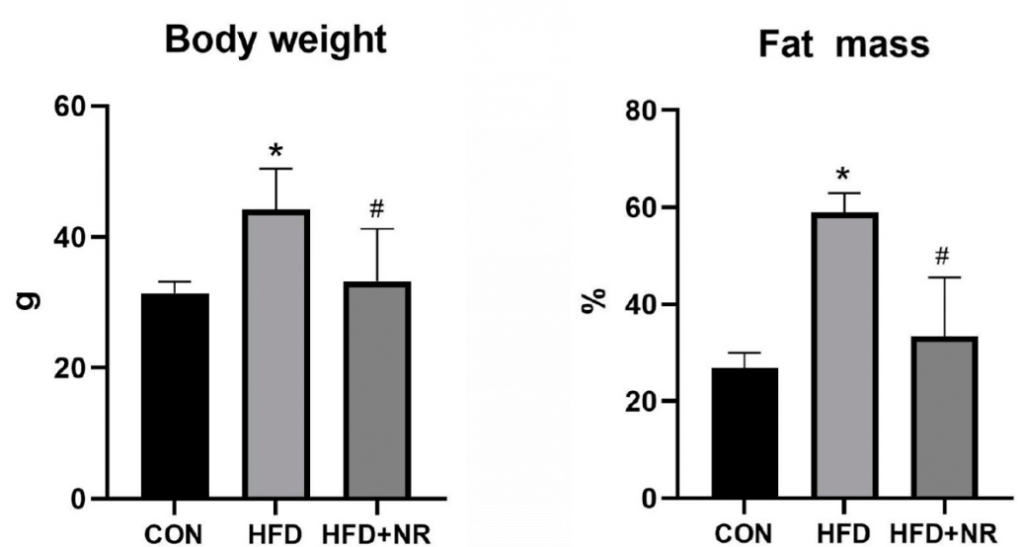Key Points:
- NR prevents the weight and fat mass gained by mice fed an obesity-inducing high-fat diet.
- Blood glucose levels are lowered and insulin resistance is prevented by NR in mice fed a high-fat diet.
- The anti-diabetes effects of NR are mediated by improving mitochondrial health and activating the longevity-associated enzyme — AMPK.
By means of diet choice, obesity and type 2 diabetes are largely preventable. Furthermore, a new study suggests that the NAD+ precursor NR can aid in obesity and diabetes prevention by activating a molecule in our cells that would normally be activated by fasting — not eating for an extended period of time — called AMPK.
This new study, from Sun Yat-sen University in China, published in the International Journal of Molecular Sciences shows that NR protects against diabetes and counters weight gain by activating AMPK. Specifically, Li and colleagues show that NR prevents fat mass accumulation, lowers blood glucose levels, and alleviates insulin resistance in mice fed a high-fat diet. NR’s effects are similar in muscle cells but abrogated when AMPK is blocked, suggesting the importance of activating AMPK for countering obesity and diabetes.
NR Protects Against Weight Gain and Diabetes
To lead them into consuming excess calories, Li and colleagues fed mice a type of mouse food containing high levels of fat (high-fat diet (HFD) mice). Over time the excess calories induced obesity, as shown by the HFD mice having body weights and fat mass levels significantly higher than mice on a normal diet. However, giving HFD mice 400 mg/kg of NR for 24 weeks largely prevented these increases in body weight and fat mass.

For humans, obesity often comes with several life-threatening complications, including type 2 diabetes. This is no different for obese mice, which Li and colleagues showed had high fasting blood glucose (FBG) levels and insulin resistance, key features of diabetes. In contrast, HFD mice treated with NR did not show these same diabetes-like characteristics, suggesting that NR can protect against type 2 diabetes.

The food we eat is eventually metabolized into cellular energy by our mitochondria, which produce reactive oxygen species (ROS) during the process. However, if our mitochondria are overworked by excess food, excess levels of ROS may be generated. As it is difficult for our cells to neutralize the overproduction of ROS, the excess ROS begins damaging not only our mitochondria but all parts of the cell they come into contact with, including DNA.
Li and colleagues found that obese mice had higher than normal levels of cellular damage caused by excessive ROS levels (oxidative stress), suggesting a problem with mitochondrial health. However, HFD mice given NR suffered less ROS-invoked cellular damage, suggesting that NR promotes mitochondrial health and limits damage to cells triggered by a high-fat diet.

The researchers also measured key mediators of mitochondrial function from the muscle of HFD mice. They found that while obese HFD mice had low activation levels of AMPK and another longevity-associated enzyme called Sirt1, NR-treated HFD mice did not show such deficits. Similar results were observed in muscle cells grown in a dish and further experiments demonstrated that many of NR’s effects are mediated by AMPK.
AMPK (AMP-activated kinase) is an enzyme that is activated in response to low energy. One function of AMPK is to make more mitochondria, which decrease as we age and are vital for cell survival. In humans, the type 2 diabetes drug metformin activates AMPK and has been shown to reduce age-related disease. Therefore, by activating AMPK and reducing blood sugar levels, NR may have similar effects to metformin, a prescription anti-diabetes medication.
Human Insulin Sensitivity: Nicotinamide Riboside (NR) vs Nicotinamide Mononucleotide (NMN)
While NR may protect against diabetes in obese mice, the same cannot be said for obese and overweight humans. In a study examining obese older men, NR did not improve insulin sensitivity or body composition. On the other hand, another NAD+ precursor, NMN, has been shown to improve insulin sensitivity in prediabetic, overweight or obese, postmenopausal women. Also in postmenopausal women, NMN improved glucose metabolism. These studies suggest that NMN may be the better choice when it comes to improving insulin and glucose levels, at least in cases of older age and obesity, although more studies are needed.